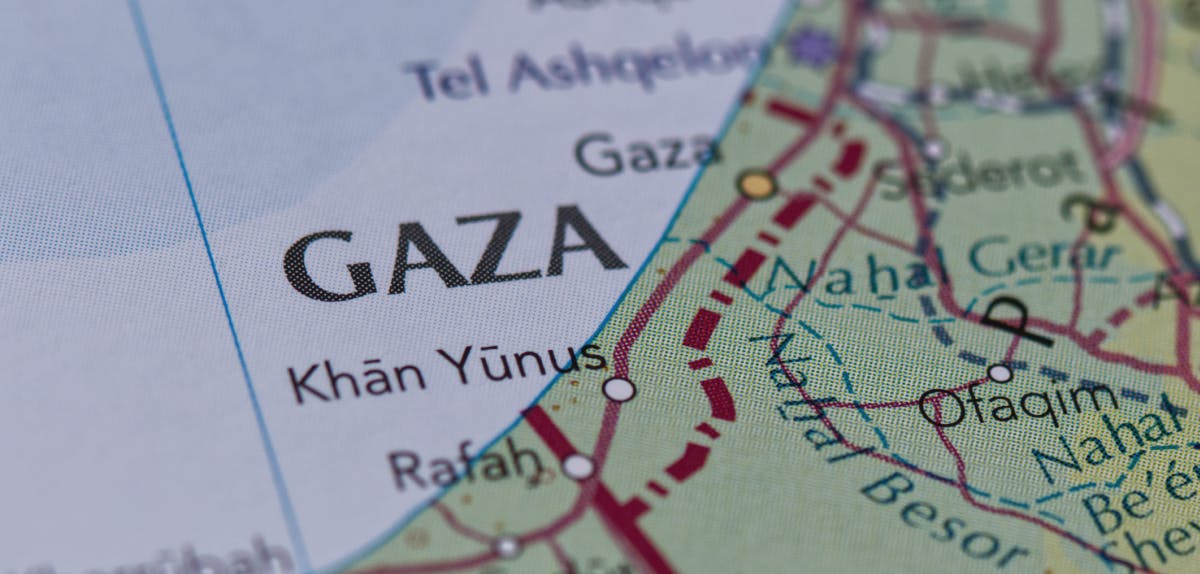Article | Why Israeli ‘occupation’ of the West Bank and Gaza has lasted since 1967
February 7th, 2024

Article by Rabbi Alan Silverstein, Ph.D. MERCAZ Olami, President
What, according to international law, is “occupation”?
Land acquired as the result of an unjust warfare — a war of aggression — is characterized as “occupied territory.” This has been the case in China’s conquest and continued occupation of Tibet since 1950, Turkey’s conquest and occupation of one third of Cyprus since the early 1970s, and Russia’s conquest and occupation of Crimea in 2014, to name a few examples.
Land acquired in a just war — a war of self-defense — is termed “disputed territory” that can be used as a basis for negotiating a stable peace.
Was Israel the aggressor in 1967, seeking the conquest of land?
No! Israel never set out to acquire territory. Rather, Israel faced an imminent war of aggression in the spring of 1967. Egypt and Syria had unified their military command and in May closed the Straits of Tiran to Israeli shipping, cutting off the Jewish state’s trade lifeline. Egypt imposed a blockade of the port city of Eilat and expelled the UN emergency peace-keeping force. Hundreds of thousands of Arab troops amassed on Israel’s borders, poised “to drive the Jews into the sea.” These steps qualified as a casus belli, an act leading to a justified declaration of war.
Was Israel justified in launching a preemptive strike in self-defense?
After weeks in pursuit of a diplomatic resolution to the crisis, Israel launched a war of self-defense, which became known as the Six-Day War. The IDF thwarted the would-be Egyptian and Syrian attackers, and after Jordan opened an eastern battlefront, defeated the Jordanian aggressors as well.
Did Israel offer to trade land for peace?
Israeli leaders were unwilling to return to the status quo of 1948-67, although it was a time of no peace treaties and marked by constant terror and periodic military assaults. They regarded the captured land as a bargaining chip to gain long-sought recognition and stability.
Nine days after the cease-fire took effect, the Knesset rushed to enact a “land for peace” policy in pursuit of a final peace agreement. Israel’s Arab neighbors rejected the Israeli overture. The Arab League met and reinforced these rejections, offering the infamous “Three No’s” — “no negotiations, no recognition, no peace.”
In the absence of a peace agreement, did the UN insist upon unilateral Israeli withdrawal?
No! The UN Security Council met and issued Resolution 242, a formula to deal with “disputed territory” in the context of a final peace agreement. Resolution 242 called upon Israel to relinquish ”territory” acquired (rejecting the phrase “all territory” or identical territory) in exchange for comprehensive treaties for “defensible borders” and an end to all claims against the Jewish state.
Israel was to transfer land only in exchange “for peace within secure and recognized boundaries, free from threats or acts of force.”
Pending a final peace agreement, was Israel justified in holding onto the “disputed territory”?
International jurist Stephen Schwebel researched the legal principles governing the acquisition of land in a war of self-defense. His conclusions:
a) A State acting in lawful exercise of its right of self-defense [read: Israel] may seize and occupy foreign territory as long as such seizure and occupation are necessary for its self-defense.
b) As a condition of its withdrawal from such territory, that State may require the institution of security measures reasonably designed to ensure that the territory shall not again be used to mount a threat or use of force against it of such a nature as to justify exercise of self-defense.”
Has Israel made reasonable efforts to end “the occupation” and achieve a two-state solution?
A breakthrough occurred a decade later, in 1977, when Egyptian President Anwar Sadat paid a surprise visit to Israel and addressed the Knesset, shattering the longstanding wall of distrust. He partnered with Israeli Prime Minister Menachem Begin and two years later concluded a peace treaty; Israel withdrew from 100 percent of the Sinai, three-quarters of all the land Israel had acquired in June 1967.
A second milestone took place in the mid-1990s, as part of the Oslo Peace Process. Jordan’s King Hussein reached a peace treaty with Israeli Prime Minister Yitzhak Rabin. Again, Israel relinquished portions of disputed territory claimed by a neighboring state in exchange for peace and an “end of all Jordanian claims” against the Jewish state.
In regard to Syria, President Bill Clinton’s negotiating team brought peace within reach. Dennis Ross, the United States’ lead negotiator, affirmed that Israeli Prime Minister Ehud Barak offered to relinquish all the Golan Heights territory taken by Israel in 1967.
To his dismay, Ross said, Syrian President Hafez al-Assad was “dismissive” of Barak’s proposal, and “for the first time in the history of the process,” Assad stated that in addition to the Golan Heights, the Sea of Galilee “‘has always been our lake; it was never theirs.’”
Once Assad demanded that Syria be given a portion of the Sea of Galilee, negotiations collapsed.
In 2005, Prime Minister Ariel Sharon conducted a unilateral withdrawal of all 8,000 Israeli settlers and all IDF troops from Gaza. He had hoped that giving Gazans the opportunity to govern would engender peaceful attitudes. Instead, Gaza became the site of terror tunnels and a launching pad for rocket attacks and fiery kites sent over the border — and the October 7 pogrom.
As for the West Bank, Israel accepted the 2000 Clinton Parameters. Yasser Arafat did not. The Palestinian leader refused to withdraw his demand that millions of Palestinian refugees be resettled inside pre-1967 Israel, which would have brought an end to an independent Jewish state. As a frustrated President Clinton said in his memoir, “Arafat never said no [to peace]; he just couldn’t bring himself to say yes.”
In her memoir, Secretary of State Condoleezza Rice confirmed that in 2008 Palestinian Authority leader Mahmoud Abbas rejected Israeli Prime Minister Ehud Olmert’s proposed concessions, even more generous than those of the Clinton plan.
Olmert was prepared to give up nearly the entire West Bank, with equivalent land swaps between the parties. He offered to divide Jerusalem, internationalizing the “Holy Basin” in the Old City. Abbas told Rice that the PA could not agree to a deal that prevented nearly four million Palestinians from being able to “go home” into pre-1967 Israel.
In March 2014. Secretary of State John Kerry formulated a “memorandum of agreement” outlining a US peace deal. Journalist Roger Cohen reported that “On March 17, [2014], in a meeting in Washington, President Obama presented Mahmoud Abbas with a long-awaited American framework for an agreement that set out the administration’s views on major issues, including borders, security, settlements, Palestinian refugees, and Jerusalem…. Prime Minister Netanyahu indicated a willingness to proceed. Abbas declined to give an answer. Abbas remained evasive on the Kerry framework.” To this day, Abbas’s reply has not been received.
What has transpired since 2014?
During the past nine years, Hamas (Gaza) and the Palestinian Authority (the West Bank) have been unable to unite. Hamas has been in attack mode against Israeli neighborhoods, culminating with the October 7 assault. Hamas’s leadership has announced its intention to repeat October 7 “a second time, a third time, a fourth time,” essentially a promise of “permanent war.”
The Palestinian Authority’s Abbas and the Fatah Central Committee announced: “The Palestinians do not accept…that the state of Israel is a Jewish state.” They reject the claim that the Jews are a “people,” insisting that they are simply “members of the Jewish religion.” For them, Jews cannot have any national rights. Moreover, they deny any presence of Jews in Eretz Yisrael until the “recent Zionist incursion,” i.e., the 20th century.
At present the Palestinian national movement is divided between Hamas and Fatah, Gaza and the West Bank. But on January 26, Nabil Abu Rudeineh, Palestinian Authority’s Deputy Prime Minister explained to Saudi television viewers the plan for a “reformed” PA. After the Israel-Hamas war, “the PA is ready to hold general elections [to unify the West Bank and Gaza], and if Hamas wins, the PA president will hand over the authority [to Hamas].” Given greatly enhanced popularity due to the October 7 massacre of Israelis, Hamas most likely would outpoll Fatah. Hamas’s genocidal ideology would reign triumphant.
In contrast, President Biden has affirmed that “until the region says unequivocally they acknowledge the right of Israel to exist as an independent Jewish state, there will be no peace.”
Conclusion — Is Israel the sole obstacle to peace?
Blame for the decades of diplomatic stalemate should not be placed upon Israel alone. This bias simply encourages Palestinian intransigence. It reduces the likelihood of a worthy outcome. At numerous points in time, Israel has been proactive, awaiting reciprocity from Palestinian leadership.
Peace requires both parties to agree to direct negotiations and to a spirit of compromise, an end of all claims, and demilitarization. Peace and security will not emerge from a one-sided chastising of Israel.
Originally published on The Times of Israel




